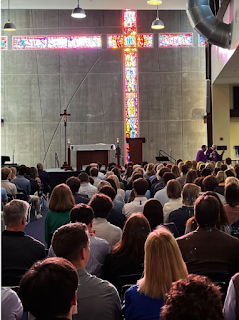Consent of Creation
Isaiah’s passage depicts a promise to the House of David, of a future to come in the form of a virgin and child. In Luke’s Gospel, we see that promise unfold as Mary gives her consent to bear the prophesized child to the angel Gabriel. These readings and those similar to them are often presented during Advent. Isaiah’s prophetic speech anticipates the coming of Emmanuel; a future revealed as the herald of hope, Gabriel, engages Mary. And it is in that encounter that the prophecy of Isaiah is fulfilled. Divine destiny unfolds, the story of Jesus is told.
But what of Mary?
Our understanding of Mary comes from snapshots of moments written long after her death, and traditions based on beliefs from the early church. We know nothing beyond these moments and yet much is revealed if one looks beyond the traditional understanding of Mary as an “obedient servant” to God’s will. Matthew’s gospel demonstrates how dangerous her response was to her life, for it is in Matthew’s gospel that we see the angel Gabriel reassuring Joseph that this was indeed God’s request, and he should honor their engagement, marry her and raise the child that was to come.
Her act was so much more than simply giving consent.
Mary’s response was bold, courageous and daring. She remained courageous, bold and daring throughout Jesus’ ministry; Mary stood at the crucifixion when so many others dared not remain.
She still stands there, bearing witness to injustice and standing with those who are the victims of injustice, greed, and power. Recently in our mass celebrating Our Lady of Guadalupe, Father Esparza, S.J. spoke on Mary as the one who stands with immigrants, people who live in the margins. Mary stands in the margins. The margins are vast, all creation can be placed within its space. For now think of it as a place where women, the poor, people of color, or anyone who is seen as different or lesser from those who are in control, live.
If we see Mary as being within this liminal space, one outside of societal norms as her yes to Gabriel implies, then we see Mary as one who works within a greater understanding of creation beyond the act of giving birth. In liminal space, Mary moves as one with the Sophia of Wisdom literature who delighted and played as creation unfolded. Mary moves the people to go beyond the limits imposed by human governance. She presses for greater understanding, compassion, and action to bring the Kingdom of God on earth as Jesus foretold would come when we truly embrace his commandment to love.
But what of Mary?
Our understanding of Mary comes from snapshots of moments written long after her death, and traditions based on beliefs from the early church. We know nothing beyond these moments and yet much is revealed if one looks beyond the traditional understanding of Mary as an “obedient servant” to God’s will. Matthew’s gospel demonstrates how dangerous her response was to her life, for it is in Matthew’s gospel that we see the angel Gabriel reassuring Joseph that this was indeed God’s request, and he should honor their engagement, marry her and raise the child that was to come.
Her act was so much more than simply giving consent.
Mary’s response was bold, courageous and daring. She remained courageous, bold and daring throughout Jesus’ ministry; Mary stood at the crucifixion when so many others dared not remain.
She still stands there, bearing witness to injustice and standing with those who are the victims of injustice, greed, and power. Recently in our mass celebrating Our Lady of Guadalupe, Father Esparza, S.J. spoke on Mary as the one who stands with immigrants, people who live in the margins. Mary stands in the margins. The margins are vast, all creation can be placed within its space. For now think of it as a place where women, the poor, people of color, or anyone who is seen as different or lesser from those who are in control, live.
If we see Mary as being within this liminal space, one outside of societal norms as her yes to Gabriel implies, then we see Mary as one who works within a greater understanding of creation beyond the act of giving birth. In liminal space, Mary moves as one with the Sophia of Wisdom literature who delighted and played as creation unfolded. Mary moves the people to go beyond the limits imposed by human governance. She presses for greater understanding, compassion, and action to bring the Kingdom of God on earth as Jesus foretold would come when we truly embrace his commandment to love.
It is time we tell Mary’s story as she moves through the liminal space created by our own will.
We need to know Mary as one who lives in the margins and stands as the Sophia.
Mary calls us to join her in her consent of creation, to build the kingdom of God as spoken by Jesus, in love and equality.
We need to know Mary as one who lives in the margins and stands as the Sophia.
Mary calls us to join her in her consent of creation, to build the kingdom of God as spoken by Jesus, in love and equality.
Author: Michele Elchlepp, Theology Dept. Chair



Comments
Post a Comment